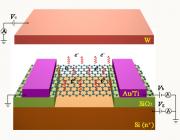摘要:
The hollow core of a carbon nanotube (CNT) provides a unique opportunity to explore the physics, chemistry, biology, and metallurgy of different materials confined in such nanospace. Here, we investigate the nonequilibrium metallurgical processes taking place inside CNTs by in situ transmission electron microscopy using CNTs as nanoscale resistively heated crucibles having encapsulated metal nanowires/crystals in their channels. Because of nanometer size of the system and intimate contact between the CNTs and confined metals, an efficient heat transfer and high cooling rates (similar to 10(13) K/s) were achieved as a result of a flash bias pulse followed by system natural quenching, leading to the formation of disordered amorphous-like structures in iron, cobalt, and gold. An intermediate state between crystalline and amorphous phases was discovered, revealing a memory effect of local short-to-medium range order during these phase transitions. Furthermore, subsequent directional crystallization of an amorphous iron nano wire formed by this method was realized under controlled Joule heating. High-density crystalline defects were generated during crystallization due to a confinement effect from the CNT and severe plastic deformation involved.
附注:
Times Cited: 0 Liu, Chang/G-4667-2012; Golberg, Dmitri/H-2776-2011 Golberg, Dmitri/0000-0003-2298-6539 1530-6992
Website
